The 10mm Auto is a powerful cartridge. When the 10mm is loaded to its full potential, it produces magnum-caliber revolver energy, and depending on the bullet and velocity, it can best the typical 357 Magnum load and come in just below the typical 41 Magnum load. That’s hot. It’s a powerful and effective round, especially in a semi-automatic.
The hapless Bren Ten was the first semi-automatic pistol to be chambered in the round back in 1983 by Dornaus & Dixon Enterprises. The second gun to be chambered in the round was the Colt Delta Elite in 1987. The 1911 platform is strong, and after a few fits and starts early on with cracked frames, Colt was able to adapt the 1911 platform to the cartridge. Part of the problem with the 10mm Auto is the pressure, which is about 37,5000 psi. The 357 Magnum has a pressure of about 35,000 psi, and the 41 Magnum has 36,000 psi. The pressure literally wants to destroy guns. Since the 1980s, other manufacturers have introduced 10mm striker-fire pistols, handguns based on the CZ-75 design, DA/SA models from Smith & Wesson, and other 1911 models. We wanted to take a look at the 1911 platform in this hot round, so we procured three 1911s chambered in 10mm Auto — a Springfield Armory (SA) Ronin, Kimber Rapide Black Ice, and Rock Island Armory Pro Match Ultra 6″.
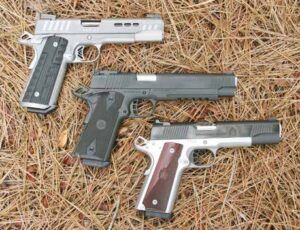
Factory 1911s can have quite a bit of variation from pistol to pistol in trigger feel and quality, as well as slide-to-frame fit, and the blending of the thumb safety and grip safety. Typically, the lower the cost, the less workmanship that goes into the 1911. Remember, a 1911 needs to be hand built and fitted. It is not like today’s striker-fire guns that are easily assembled. The hand-fitting is also why some 1911s are finicky about ammo and running smoothly.
All three of these 1911s are very similar. It’s the details that separate them. The SA and Kimber feature 5-inch barrels, and the Rock Island Armory (RIA) does them one better with a 6-inch tube. The RIA and SA have thinner grips and no magazine well, while the Kimber grip is thick, and it has a magwell for smoother reloads. Another common feature are highly visible and usable sights. The RIA goes a step further with a fully adjustable rear sight, while the Kimber and SA have driftable rear sights.
How We Tested
We did experience a failure to eject and a failure to slide lock back on the Kimber, but that was with the first magazine. From then on, no issues. The RIA also experienced an initial failure to lock the slide back. We attribute these issues to needed break in. After those minor hiccups, the pistols ran flawlessly. The Springfield ran flawlessly from the get go.
We averaged 1- to 1.5-inch five-shot groups at 15 yards across all three pistols. There is a reason why many shooters like the 1911 platform’s single-action trigger. With all of these pistols, we were able to shoot our best groups under 1 inch using a rest. In many instances, holes overlapped each other. With more range time, we are certain we could easily tighten the groups with any of these guns.
Ammo used during testing consisted of Federal Premium HST 200-grain JHP defense rounds and two training rounds; Magtech and Armscor loads with 180-grain FMJ bullets. All three of these loads cranked out of the muzzle doing a respectable 1100 fps, on average. This is powerful ammo, and when we tabulated the data, we found it accurate as well. Using a rest, we fired at Thompson Trouble Shooter targets set at 15 yards. All three pistols showed good to excellent accuracy. The RIA was exceptionally accurate, with many tight groups showing touching bullet holes.
Recoil was stout, so don’t think a 10mm Auto is for the faint of heart or recoil shy. The Kimber and RIA have front grip strap texture that helps with grip control. This additional texture helps to prevent grip slippage from recoil when the gun is fired. These guns did a good job of recoil management, and the RIA offered faster follow-up shots due to the extra weight.
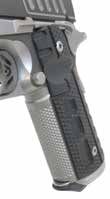
We tested the guns’ fast-shooting qualities at 15 yards using a plain 8.5-by-11-inch white piece of paper with a 2-inch black square printed in the middle. We fired fast, at the edge of control, and we were able to keep rounds on target. We needed to lean into the pistol because recoil is fast and snappy, and it can get away from you if you are not paying attention. You don’t want to shoot a 10mm fast standing on your heels. We stood on the balls of our feet with knees slightly bent. Most fast-shooting groups we could cover with our hand. We also noticed the web of our hand was getting a workout. No abrasion from any of the guns, but we did notice some grips were more comfortable, namely the SA and the RIA. The Kimber grips have a high cool factor and were comfortable, but not as comfortable as the grips on the other two guns. Some of our testers grip a 1911 and ride the controls, meaning a right-handed shooter will rest the shooting-hand thumb on the thumb safety and the thumb of the support hand on the slide stop. Those with average to small hands noticed the larger grip circumference of the Kimber compared to the SA and RIA, and in some cases needed to change their grip for better trigger control. We also swapped magazines between guns to see if we could trip up any of them. We had no feeding issues.
That’s the high-level view of these 10mm pistols, now let’s get into the weeds.
Gun Tests Grade: A-
$1499
At the high end of the price scale is the Rapide Black Ice. This is a stylish 1911 that borders on a custom-gun look and feel. Yes, this is a sleek and sexy looking 1911, but is it all looks and no game? Kimber took the time to think out the details on this 1911 model. The Rapide Black Ice has the looks, performance, and accuracy to thrill most any shooter.
| Action | Semi-auto, locked breech single action |
| Overall Length | 8.7 in. |
| Overall Height | 5.2 in. |
| Maximum Width | 1.4 in. |
| Weight Unloaded | 38 oz. |
| Weight Loaded | 44.6 oz. |
| Barrel | 5.0 in. |
| Capacity | 8+1 |
| Slide Retraction Effort | 18.0 lbs. |
| Slide | Silver/gray KimPro II, stainless steel |
| Frame | Silver/gray KimPro II, stainless steel |
| Frame Front Strap Height | 2.6 in. |
| Frame Back Strap Height | 3.5 in. |
| Grips | Black, textured G10 |
| Grip Thickness (max) | 1.3 in. |
| Grip Circumference (max) | 6.3 in. |
| Front Sight | Fixed, low profile Tru-Glo TFX Pro Day Night |
| Rear Sight | Low profile Tru-Glo TFX Pro Day Night |
| Trigger Pull Weight SA | 5.0 lbs. |
| Trigger Span Single Action | 2.9 in. |
| Magazines | 1; stainless steel |
| Safeties | Thumb, beavertail grip |
| Warranty | Limited 1 year |
| Made In | U.S.A. |
| Website | KimberAmerica.com |
The pistol came in a hard case with one stainless-steel magazine, a polymer bumper pad, and plastic bushing wrench. For the price, we would have appreciated a second magazine.
In hand, the Rapide’s fuller grip fills your hand. You also notice it is lighter than the Ronin.
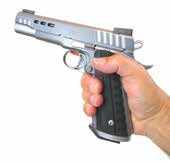
What catches your eye with this Kimber are the stepped cocking serrations fore and aft on the slide. The slide also has cut-outs in the top and sides to lighten it. Kimber says the windows lighten the slide mass, allowing it to cycle and lock faster. We noticed the RIA cycled slightly slower, and that is due to the extra barrel and slide. On the Kimber, it was hard to tell if the lighter slide cycled faster because the 10mm Auto cycles so fast in most guns. We found no wiggle in the barrel, nor any jiggle in the slide-to-frame fit.
The finish is sublime and adds to the cost of this 1911. It wears a premium three-tone finish. The barrel has a durable, black diamond-like-carbon (DLC) coating that matches the sights, grip panels, and magazine bump pad. The stainless-steel slide and frame are treated with a gray KimPro II finish. The aluminum trigger is anodized to match. The gray finish used on the flat surfaces of the slide and frame is a shade darker than the natural silver color of the stainless-steel controls. There is a lot of machine work on this gun, and in our view, it is tastefully executed.
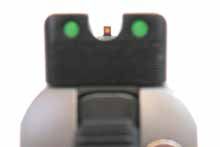
The coarse slide serrations allow for easy racking and press-check maneuvers. The top of the slide is milled flat. Tru-Glo TFX Pro Day/Night Sights are dovetailed in place in the front and rear. Both front and rear sights use green fiber-optic pipes. The front also has an orange ring around the green fiber optic for contrast. The U-shape notch in the rear sight is wide and provides quick sight acquisition. The rear sight also has a ledge that can be used for one-handed cocking. We liked these sights, and the range data agrees. The Rapide came in second in accuracy. The trigger face is serrated, and travel can be adjusted. It broke at 5 pounds, which was okay. If the trigger pull were a pound lighter, we think we could easily tighten up the groups we fired with the Kimber.
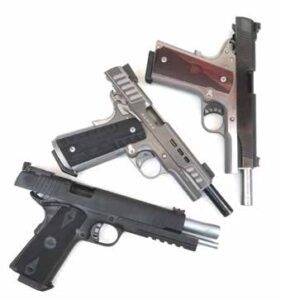
The match-grade linked barrel is supported by a traditional G.I.-style barrel bushing with a single round-wire recoil spring topped with a smooth-faced plug. The receiver/frame is similar to a G.I.-style frame with no accessory rail. The front grip strap wears has a unique undercut that is cut into the frame in a straight line about 0.25 inches wide. Kimber textured the rest of the frontstrap in the company’s dimpled Stiplex pattern texturing. This texture provides a solid grip with no abrasion to the user’s hand. The mainspring housing is machined out with three rectangles patterned after the cutout windows in the slide. The butt is fitted with a beveled, low-profile aluminum magazine well that makes faster and smoother reloads much easier. The magwell is nicely fitted and blended with the grip panels.
The G10 grip panels are large with multiple texture types and a rectangular pattern that matches the mainspring housing and slide. The gripping fingers of your shooting hand naturally fall into three of the rectangular indents and offer a good grasp. There is also a nice cutout for a user’s thumb to access the magazine release. Some testers thought the grip was too large since they couldn’t easily ride the thumb safety when firing.
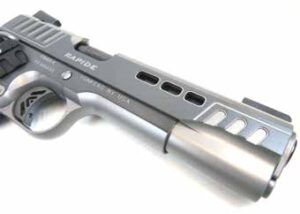
The slide stop and ambidextrous thumb safety were oversized and easy to manipulate. We felt the left-side thumb safety could have been blended better at the rear where it contacts the web of the user’s hand. We liked the magazine release because it was taller and checkered and offered a faster press compared to the other 1911s.
Going hot with accuracy testing, we found the Rapide was not just another pretty face. The best five-shot group was with the 180-grain FMJ Magtechs, which measured 0.7 inches. The Federal Premium HST with a 200-grain JHP came in a close second at 0.8 inches. The Armscor 180-grain FMJs had a best group of 1.2 inches. With all ammo tested, we averaged 0.9 to 1.3 inches at 15 yards. Yep, fancy shooting for a fancy gun. We did encounter one failure to extract and one slide lock failure with the initial magazine. Thereafter , we had no stoppages and no issues, even when swapping magazines.
For speed shooting, we liked how the Rapide cycled. The sights and the trigger helped to keep us on target and offered control at speed.
Our Team Said: The Rapide is a beautiful 1911 that also performs. You pay the price for beauty, but hey don’t you need a new barbecue gun? If so, this is a good choice.
10mm Auto Range Data
| Magtech 180-grain FMJ | Rock Island Armory Pro Match Ultra 6" | Kimber Rapide Black Ice | Springfield-Armory 1911 Ronin |
| Average Velocity | 1199 fps | 1165 fps | 1180 fps |
| Muzzle Energy | 575 ft.-lbs. | 543 ft.-lbs. | 567 ft.-lbs. |
| Smallest Group | 1.1 in. | 0.7 in. | 1.5 in. |
| Average Group | 1.2 in. | 0.9 in. | 1.6 in. |
| Federal Premium HST 200-grain JHP | Rock Island Armory Pro Match Ultra 6" | Kimber Rapide Black Ice | Springfield-Armory 1911 Ronin |
| Average Velocity | 1132 fps | 1130 fps | 1144 fps |
| Muzzle Energy | 569 ft.-lbs. | 567 ft.-lbs. | 581 ft.-lbs. |
| Smallest Group | 0.6 in. | 0.8 in. | 0.8 in. |
| Average Group | 0.8 in. | 1.3 in. | 1.1 in. |
| Armscor 180-grain FMJ | Rock Island Armory Pro Match Ultra 6" | Kimber Rapide Black Ice | Springfield-Armory 1911 Ronin |
| Average Velocity | 1117 fps | 1088 fps | 1113 fps |
| Muzzle Energy | 499 ft.-lbs. | 473 ft.-lbs. | 496 ft.-lbs. |
| Smallest Group | 0.7 in. | 1.2 in. | 0.9 in. |
| Average Group | 0.8 in. | 1.3 in. | 1.1 in. |
| Gun Name | Issue | Grade | Comments |
|---|---|---|---|
| Smith & Wesson M&P40 M2.0 11522 40 S&W, $581 | Oct. 2021 | A | Best Buy. The 18-degree grip angle made the M&P M2.0 feel natural. The trigger was very consistent. |
| Glock G23 Gen5 PA235S203 40 S&W, $700 | Oct. 2021 | A | Recoil management was excellent. We like the flared magwell, front slide serrations, and improved trigger pull. |
| Heckler & Koch P30S-V3 81000127 40 S&W, $859 | Oct. 2021 | A- | The P30 is the benchmark for a DA/SA-style pistol with an excellent grip and sights and good accuracy. |
| SIG Sauer P239 23940BSS 40 S&W, $600 | Oct. 2021 | A- | Recoil was controllable and accuracy was good. Design felt dated, but we’d consider buying a used P239. |
| Springfield Armory XD-M 5.25 10mm Auto, $681 | Sept. 2020 | A- | Best Buy. To take backpacking in the boonies, the XD-M and its 16-round payload might well be our choice. |
| Colt Delta Elite 02020RG 10mm Auto, $1134 | Sept. 2020 | A- | When we were firing the Buffalo Bore stompers, we were just fine with the Colt’s smooth front strap. |
| SIG Sauer Tacops 10mm Auto 1911R-10-TACOPS, $1050 | Sept. 2020 | B/A- | Had extraction issues initially. SIG fixed the problem fast, so we upgraded its marks to include customer service. |
| Lone Wolf TWL-S Frame/Gray Man Slide 10mm, $884 | Aug. 2020 | A | The Grey Man G20 is a handful. The small grip made this pistol easier to conceal. Trigger was excellent. |
| Springfield XD-S 3.3-Inch XDS93340BE 40 S&W, $378 | Sept. 2019 | A | Best Buy. Completely reliable, accurate enough for personal defense. Useful trigger action and good sights. |
| Kahr CW40 CW4043 40 S&W, $301 | Sept. 2019 | B | A well-made and reliable handgun, despite a number of corners being cut to offer the pistol at a low price. |
| SIG Sauer P224 SAS 224-40-SAS2B 40 S&W, $800 | Sept. 2019 | B | A compact pistol with a short barrel and grip that takes some getting used to, yet excellent accuracy. |
| Taurus G2C 1-G2C4031-10O 40 S&W, $250 | Sept. 2019 | B | An upgrade over the original, with superior grip treatment and a new matte-finished slide. |
| Smith & Wesson Shield 180020 40 S&W, $337 | Sept. 2019 | D/D | We tested two Shields, one with a safety and one without. The 180020 with safety short-cycled. The 10034 non-safety Shield had a failing trigger return spring that caused a stoppage. |
| Glock G40 Gen4 MOS 10mm Auto, $706 | Mar. 2019 | A | Longer sight radius and ability to mount a red-dot optic made the G40 a close contender for top dog in the test. |
| Springfield 1911 RO Elite Operator 10mm Auto, $1145 | Mar. 2019 | A | Well adapted for the 10mm cartridge. We like the sights and love the trigger. Grip texture is a bit raspy. |
| Springfield Armory XDM 10mm Auto, $779 | Mar. 2019 | A | Best Buy. Great ergonomics, nice grip angle, modular grip strap, crisp trigger, nice sights. Reasonable cost. |
| Glock G35 Gen3 PI3530103 40 S&W, $560 | Jul. 2017 | A | The G35 in 40 S&W is a good competition pistol. A 9mm barrel makes it more affordable to shoot. |
| Smith & Wesson Model 1076 10mm Auto, $800-$825 | Nov. 2017 | A- | As a compact 10mm, a used 1076 is an excellent choice. Trigger could have been better. |
| Colt Delta Elite O2020XE 10mm Auto, $1099 | Nov. 2017 | A | The latest Delta Elite is an excellent full-size 1911 chambered in 10mm. We liked the trigger, sights, grip. |
| EAA Tanfoglio Witness 10mm Auto, $665 | May. 2017 | A | Best Buy. Relatively compact and accurate, plus it is affordable. |




























